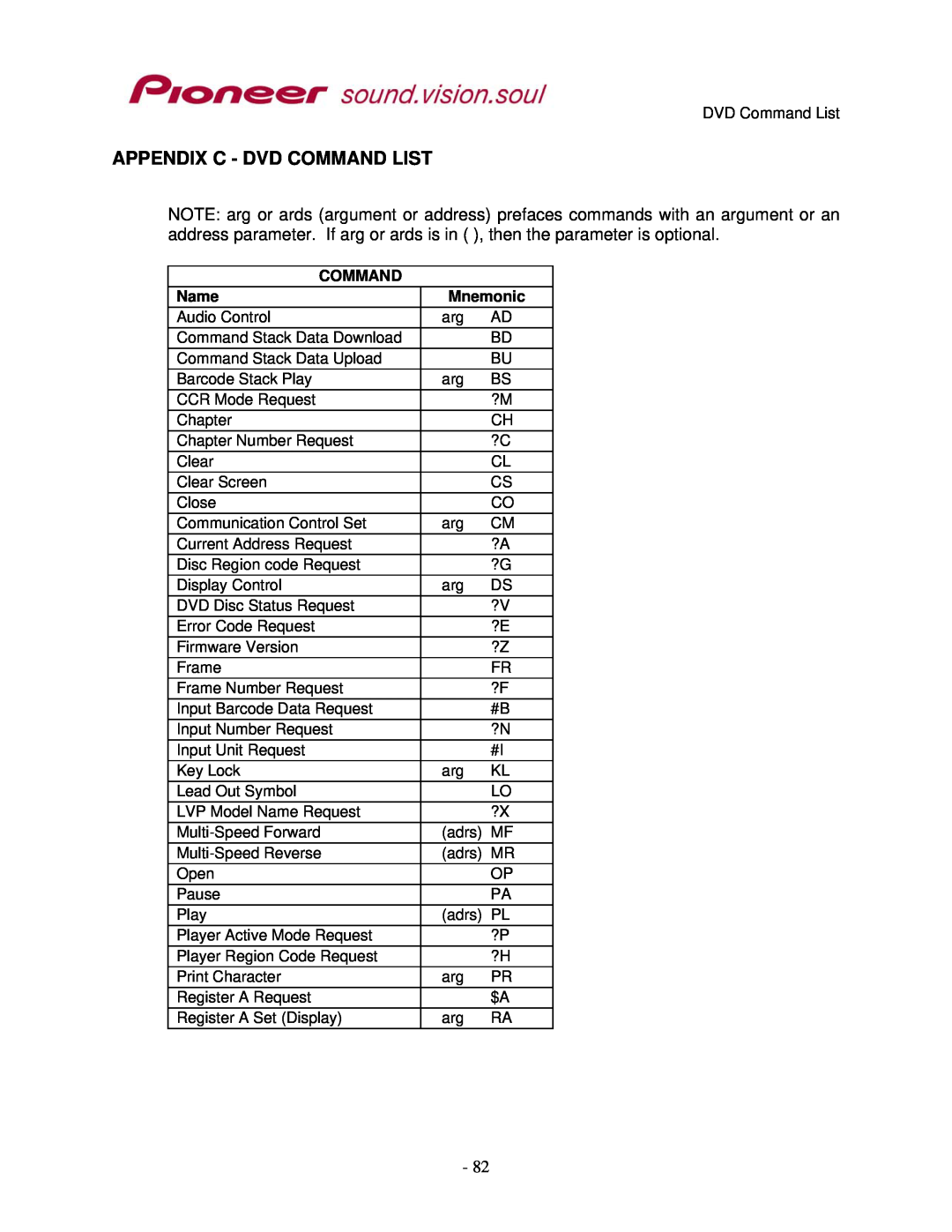Manual Version June 30
Business Solutions Division
Pioneer Corporation Pioneer Electronics USA Inc
DVD-V5000
Copyright c 2004-2005 Pioneer Electronics USA Inc
Information in this document is subject to change without notice
Document No. V5000RS232CPM-100
Printed in the United States of America
SAFETY CAUTION
verify the cables and connectors between components are shielded
FCC INFORMATION
increase separation between the player and components
4. COMMAND STRUCTURE
Table of Contents
5. COMMAND DESCRIPTIONS
INTRODUCTION
6. CURRENT PLAYER CONDITION REQUEST Descriptions
DVD-V5000 INTERNAL REGISTERS
OPERATING MODES
EXTEND TERMINAL CONTROL
Description
1. INTRODUCTION
Chapter Number
2.2 Serial Interface Pin Specification
2. INTERFACE 2.1 Interface Connector
Pin #
Terminal
Input/Output
2.3 Computer Control Functions
more than 100 msec
Power ON mode
Power OFF
3.2 Communication with a Computer
3. SERIAL CONTROL 3.1 Serial Interface Specifications
3.1.1 Signal Interface
3.1.2 Data Type
3.3 Command and Status
?P to determine the Active mode of the player
3.5 Initial Setting
3.4 Error Messages
Register/Switch
Setting at Power ON
COMMAND
4. COMMAND STRUCTURE
Name
Mnemonic
SUPPORTING FORMATS
4.2 Argument
4.1 Command Mnemonic
4.3 Command String
4.6 Request Status Return
4.5 Error Message
4.4 Status Returns
4.7 Timing
RxD P TxD
Execution
5.2 Close
5. COMMAND DESCRIPTIONS 5.1 Open
5.3 Reject
Door Opens Tray Ejects
Start
Error - No disc in tray
5.3.1 Reject
5.5 Play
5.7 Still DVD, VCD
5.6 Pause
plays to 3 minutes
seconds
5.9 Scan Forward, Reverse, or Stop
5.8 Step Forward or Reverse DVD
Moves
Frame forward
5.10 Multi-Speed Forward or Reverse DVD
plays to 3 min. 25 secs
5.11 Speed DVD, VCD
Search to specified address
5.12 Search
Search to Frame
5.13 Search & Play
4500
Address Mode set = Frame
5.14 Stop Marker
⇒ Still mode
5.15 Lead-Out Symbol
plays to 3 minutes 25 seconds
Time code in program end area
5.16 Clear
Continue playing to lead-out and
then return RCR
5.18 Block Number CD
5.17 Frame DVD
5.19 Time excludes discs without Time Codes
searches to Frame
5.21 Title DVD
5.20 Chapter DVD
Search to 123 min
secs
5.24 TRACK CD, VCD
5.23 Index CD
5.25 Select Subtitle DVD
IX1204SECR Search to Index 4, Track
5.28 Select Angle DVD
5.26 Select Audio DVD
5.27 Select Aspect DVD
5.30 Audio Control DVD, CD, VCD
5.29 Select Parental-Level DVD
5.31 Video Control
Register A
5.32 Display Control
Display condition is set on
The key lock switches ON / OFF
5.33 Key Lock
Execute Barcode/Command Stack
5.35 Barcode /Command Stack Play DVD
5.34 Stack Group Set DVD
bytes
5.36 Stack Data Upload
Numbers of
1 Fixed data
Example Segment Play Command Title 02, from Frame 3600 to Frame 4800
5.37 Stack Data Download
6.1 P-Block Number Request
6. CURRENT PLAYER CONDITION REQUEST DESCRIPTIONS
6.2 Title/Track Number Request
Track 12, Index 1, 3 minutes
6.4 Time Code Request
6.3 Chapter Number Request DVD
Player plays Track
Player plays Chapter
6.6 Frame Number Request DVD
6.5 Block Number Request CD
32 minutes, 13 secondsCD/VCD
117 minutes, 42 secondsDVD
6.8 Total Frame Request DVD
6.7 Index Number Request CD
6.9 TOC Information Request CD/VCD
Track 1, Index
6.11 DVD Disc Status Request
6.10 Disc Region Code Request DVD
first Track is 1, last Track is
lead-out Time is 66 min, 55 sec
Error - except DVD disc loaded
disable Time Search
6.12 CD Disc Status Request
Disc is not mounted
Time
6.13 Register A Set
Track
The screen display positions are pictured below
Only Frame number is displayed
6.14 Register D Set
6.15 Print Character
Register A and Display control
6.16 Clear Screen
Select Line
Displays the characters like this
Title repeat mode
6.17 Advanced Setup
Baud rate is 9600bps
Tray lock on
6.18 Communication Control Set
CCR = 3 Default Communication Mode
6.19 Player Active Mode Request
to CCR = 2 Communication Mode-2
Series name P1570 and code
6.21 Advanced Setup Request
6.20 Player Model Name Request
6.23 CCR Mode Request
6.22 Player Region Code Request
6.24 Input Number Request
Region Code
7 entered from remote controller
6.25 Error Code Request
Receives the Pause Key command -A39F
6.26 Input Unit Request
6.28 Register A Request
6.27 Input Barcode Data Request
6.29 Register D Request
Receives a Play code about DVD disc
Sets the Register D
6.30 Menu Call DVD
Requests information from
Register D
6.32 Button Select DVD
6.31 Numeric Button DVD
6.33 Enter Button DVD
X1 X2 X3 Y1 Y2 Y3
6.34 Get Information DVD
Others
Contents
6.35 Memory Data Upload
Returns current firmware version
6.36 Return Firmware Version
7.4 Random Access
7.3 Setup
7. OPERATING MODES
7.1 Open
7.5 Reject
8.7 Remote Control Digit Buffer
8.6 Remote Control Use Address Flag
8. DVD-V5000 INTERNAL REGISTERS
8.1 Current Time/Frame
8.9 Laser Barcode Buffer
8.8 Remote Control Data Register
8.10 Serial Use Address Flag
8.11 Search Time/Frame
8.16 Mark Index
8.15 Mark Title/Track Mark Chapter
8.17 Video Control
8.18 Audio Control
REGISTER MODEL
9. EXTEND TERMINAL CONTROL
Function
9.1 Function Assignment
STACK GROUP8
STACK GROUP7
STACK GROUP9
STACK GROUP10
9.2 Function User Setting
RIGHT Button
DOWN Button to select MENU
ENTER button to change the function of switch 8 to MENU
For an initial setting, Standard and User are the same
9.3 Controller
9.2.2 Diode Matrix Circuit
10. ADDITIONAL NOTES
FORMATS
APPENDIX A - COMPLETE COMMAND LIST BY NAME
SUPPORTING
SUPPORTING
APPENDIX B - COMPLETE COMMAND LIST BY MNEMONIC
SUPPORTING
APPENDIX C - DVD COMMAND LIST
Name
APPENDIX D - CD COMMAND LIST
arg VD
APPENDIX E - VCD COMMAND LIST
Name
APPENDIX F - ERROR CODES
Business Solutions Division 2265 East 220th Street
Industrial DVD Player RS-232 Command Protocol
DVD-V5000
Pioneer Electronic Corporation

